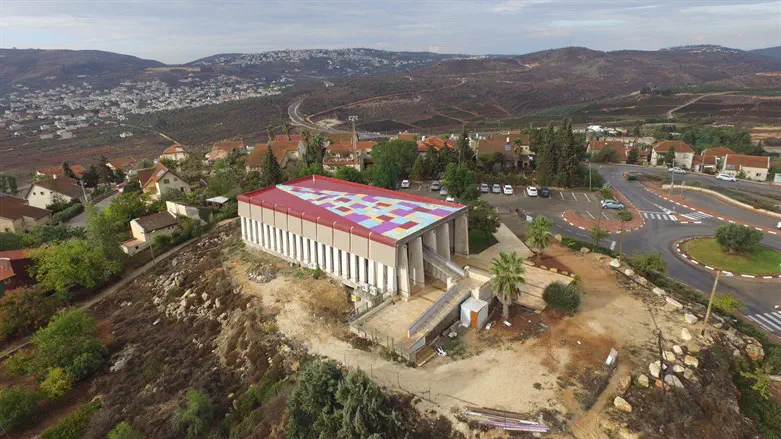
Ever since the yearly cycle of Torah readings was standardised towards the end of the Second Temple era, and the fixed calendar as calculated by Hillel II (Hillel ben Yehudah, Nasi or head of the Sanhedrin) was adopted in 4119 (359 C.E.), Parashat Terumah almost always falls on the first Shabbat in Adar (in leap years, the first Shabbat in Adar I).
Very occasionally (on average one year in ten), Parashat Terumah falls on the second Shabbat in Adar or Adar I.
This prompts the question: Is there any connexion between Parashat Terumah and the month of Adar?
“When the month of Adar enters, we increase in joy”, said Rav Yehudah, the son of Rav Shmuel the son of Shilat, in the name of Rav (Ta’anit 29a), defining Adar’s identity; Adar began on Wednesday.
Last Shabbat, Parashat Mishpatim concluded with Moshe ascending into the cloud enveloping Mount Sinai, where he was to stay for forty days and forty nights for G-d to give him the Torah (Exodus 24).
This Shabbat, Parashat Terumah continues with G-d telling Moshe, atop of Mount Sinai, to collect the voluntary contributions from the Children of Israel with which to build the Mikdash (Sanctuary):
“Hashem spoke to Moshe saying: Speak to the Children of Israel, that they shall take a donation for Me from every man whose heart inspires him... And they shall make for Me a Mikdash and I will dwell among them” (Exodus 25:1-8).
From here until the end of the Book of Exodus, the building of the Mikdash will be the sole theme (with the unfortunate hiatus of the sorry episode of the golden calf in Chapters 32-33).
In non-leap years (like this year 5783), the final Shabbat of Adar is invariably the conclusion of the Book of Exodus (usually the double parashah Vayak’hel-Pekudei, sometimes the Parashat Pekudei by itself). In leap years, the final Shabbat of Adar I is either Parashat Pekudei, concluding the Book of Exodus, or else Parashat Vayak’hel, meaning that the first Shabbat of Adar II is Parashat Pekudei, concluding the Book of Exodus.
This means that the Torah-readings for all the Shabbatot in Adar – the month in which we increase our joy – concern the preparations for building the Mikdash.
Let us come back to Rav Yehudah’s aphorism with which we opened, and see the context in which it appears:
“When the month of Av comes in we minimise our joy; said Rav Yehudah, the son of Rav Shmuel the son of Shilat, quoted Rav as saying: Just as when the month of Av comes in we minimise our joy, so too when the month of Adar enters, we increase in joy” (Ta’anit 29a).
The month of Av is the month in which both Holy Temples were destroyed, which is why “when the month of Av comes in we minimise our joy”.
And the corollary is that it is supremely appropriate that the Torah-readings for the entire month of Adar, the month in which we increase in joy, prepare us for the building of the Mikdash in the wilderness – the temporary, portable structure which served as the paradigm for the future permanent Holy Temple which would stand in Jerusalem.
The prologue to the month of Adar, so to speak, was last Shabbat, Shabbat Shekalim. The Maftir (the paragraph from the Torah which concludes the Torah-reading) for Shabbat Shekalim is Exodus 30:11-16, the requirement that every Israelite man aged 20 years or more donate half-a-shekel every year for the upkeep of the Mikdash, later in history for the upkeep of the Holy Temple in Jerusalem).
And building the Mikdash was the prerequisite for G-d infusing His Shechinah [Divine Presence] into the Jewish nation: “Rabbi Tarfon said: G-d did not infuse His Shechinah over Israel until they performed work, as it says ‘and they shall make for Me a Mikdash and I will dwell among them’ (Exodus 25:8)” (Avot de-Rabbi Natan 11:1).
The Ba’al ha-Turim (Rabbi Ya’akov ben Asher, Germany and Spain, c.1275-1343) notes that the word וְשָׁכַנְתִּי (I will dwell) alludes both to the First and the Second Holy Temples:
The first, because the word וְשָׁכַנְתִּי suggests וְשָׁכַן ת"י, meaning “He will dwell for 410: the First Holy Temple stood for 410 years.
And the second, because the letters of the word שָׁכַנְתִּי rearrange to form שְׁנֵי ת"ך, meaning “420 years”, the time that the Second Holy Temple stood.
And I note here that the phrase וְשָׁכַנְתִּי בְּתוֹכָם (and I will dwell among them) occurs only twice in the entire Tanach: the first time is here in Parashat Terumah, and the second is in the Book of Ezekiel, when the Prophet depicts the third and final Holy Temple:
“Now let them distance their harlotry, and the corpses of their kings from Me – וְשָׁכַנְתִּי בְּתוֹכָם, and I will dwell among them forever” (Ezekiel 43:9).
As with building the Mikdash in the Sinai Desert, as with building the First Holy Temple, as with building the Second Holy Temple, so too with building the Third and final Holy Temple:
G-d will dwell among us when we seize the initiative and start doing the work, putting brick upon brick, constructing the Holy Temple on the Temple Mount in Jerusalem.
מִשְֶׁנִּכְנַס אֲדָר מַרְבִּין בְּשִׂמְחָה, when the month of Adar enters, we increase in joy. This is not merely some insubstantial philosophical homily, it is actual practical halakhah (Mishnah Berura 686:6, Kitzur Shulchan Aruch 141:1).
The time is now: there is no reason to wait, no reason to delay. This is what our Sages infused us with by calibrating the calendar so that we would read Parashat Terumah as Adar begins.